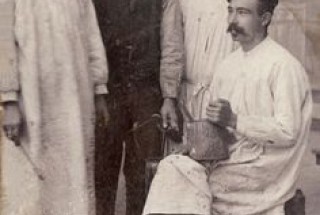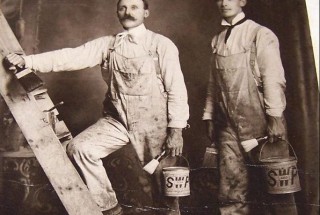
Why Painters Wear White
Daniel Wurm | 30 Aug 2022
Have you ever wondered why professional painters wear white? Is it just tradition, or are there good reasons to choose the colour of your work wear? Does it really matter?
I've been in the painting industry 29 years, but I have to admit there was a time when I couldn't understand why the colour of my workwear mattered. In fact, during my apprenticeship I refused to wear white for the first two years because I thought it wasn't cool, and because I couldn't afford to buy proper work wear. I still remember arguing with my employer at the age of 24 about what I wore to work, because I wanted to wear comfortable, fashionable clothing, and he wanted his employees to wear white work wear. At the time I couldn't understand it, and I simply rebelled and wore whatever I wanted. I'm pretty sure the only reason he kept me as an employee was because I was a bloody good painter, not because of my attitude.
But after starting my own business at the age of 26 the penny finally dropped, and I realised the benefits of wearing the traditional colours of our trade. I now believe that there are many practical reasons to follow this tradition, even if we update the style of clothing we wear.
History of Painters Clothing
The tradition of wearing white dates back over 400 years, to when painters used to make their own paint. The oxides and powders used were often white, because many other hues simply were not possible. To look cleaner, painters would wear light coloured clothing. In fact, painters painting ships would use the white sail cloth to make their workwear.
Above: Painters in France wearing traditional white workwear
In the 1800s in Europe and the United States, painters unions were formed. The purpose of the unions was to unite and protect the trade from unprofessional people and unscrupulous businesses, so the unions adopted the uniform of professional painters. Painters who were union members would wear white to show that they were professional, proud of their trade, and proud of being a union member. It became easy to tell who was a professional painter, and who was a dodgy amateur. Union painters would wear all white clothing and caps, and often would wear a bow-tie to complete the look. White became the uniform of professional painters, and instantly identified the wearer as a professional painter and decorator.
Above: Painters in the 1800s wore white to identify themselves as professional
In the 1930s clothing became more practical, and overalls were adopted. This workwear allowed the wearer to carry small hand tools such as duster brushes or scrapers in pockets or pouches, so that they could be easily accessed while working. But white was still the colour of choice, because it was identified with the trade. Carpenters wore brown overalls, plumbers wore blue, and painters wore white.
Today, the colour white is still associated with the trade, and most workwear for painters is still white. Although overalls are still popular with painters in Europe, t-shirts, shorts, and pants are more popular in countries with warm climates.
In view of the above, it is clear that one of the main reasons for painters to wear white is because it has traditionally identified the wearer as a professional painting trades person.
Practicality
There are also practical reasons to wear white. The majority of paint used is still coloured white or off-white, especially ceilings, so by wearing white it disguises most paint splatter as much as possible.
Here's a fact; If you wear fashionable dark coloured clothing while painting and get paint splatter all over you, you don't look cool anymore; you just look like a DIY amateur!
Trade Identity
Why is it still a good idea to wear white as much as possible, and to require your staff to wear white?
One of the main reasons is because of how the trade, including your staff are perceived by your clients. The general public still identify a person performing building maintenance while wearing all white as a professional painter. Being able to quickly identify a person based on what they wear is important to many professions. For example, police and emergency workers wear uniforms so they are easily identified by the public. People wearing these uniforms are trusted by the public, and trust is very important for organisations, and for business. Doctors and nurses working in a hospital wear uniforms and ID badges because it identifies them as experts in their workplace. Imagine if professional people such as paramedics, or nurses just wore whatever they felt like? You would not be able to tell who was who, and whether you could trust them.
Being able to instantly identify someone as a painter makes a big difference to the level of trust the public have in us as professionals, and on the job. For example, the reason why my employer wanted me to wear white was because most of our work was repainting apartment blocks. Our team would be opening windows and doors almost every day. We would climb onto balconies, and enter people's private spaces. Someone might easily mistake us for burglers or thieves unless they could quickly identify us as painters. By wearing white it instantly made people feel more at ease when they saw us opening doors, windows or accessing private property. This applies to any painter doing painting maintenance on occupied buildings.
Trust is a big part of the reason why a potential client chooses a business to perform work. If you thought it was all about price, think again. If you find you are losing a lot of work to other painters it might pay to think about how you present yourself to your clients, especially when quoting or bidding for a job. If they open the door and see you dressed as a professional painter, with a neat, clean white uniform, it often raises their level of trust in you as a professional trades person, because that's what they expect a professional painter to look like. Conversely, if you look like any other trade, or are wearing coloured clothes covered in paint; you don't look like a professional painter; you just look like a handyman, an amateur, or even worse, a homeless person!
Some painting contractors wear neat casual clothes do their quoting. Even though there is nothing wrong with doing this, I found that wearing white helped me gain the trust of the client. If you look like a painter, people are more likely to trust what you say about their painting project, and you can charge more. Look professional, and you'll be paid like a professional.
Do You Look Like a Painter?
Perception matters, even if you don't want it to. No matter how much you think people shouldn't judge your skills based on how you look, they do. It's human nature.
I'm sure you have often seen people walking down the street, or in the shops, wearing dark coloured clothes covered in paint. What does this signal? It says;
"I'm just a DIY or handyman painter and I'm not really good because I've got paint all over myself."
Unconsciously or consciously, people will make that judgement based purely on appearances. Contrast that with a person wearing white overalls also covered in paint splatters. If you saw someone wearing white overalls you would naturally think they are a professional painter, even if they are not! That is the power of identity and perception.
Many painters often get asked to give a quote while going about their daily business, just because they were identified as a painter by someone who was thinking about getting some painting done. Wearing your whites can actually help you find work.
Above: Who would you want painting your home? What we wear matters
In recent years there has been a move away from wearing white, mainly because many construction sites require high visibility clothing as part of their PPE requirements. There are ways to meet these requirements, while still looking and dressing like a painter. There are now ranges of white workwear with reflective strips, or high visibility white workwear, that allow a professional painter to meet the PPE and safety requirements, while wearing clothing that is practical and identifies them as a trades person.
Don't feel you need to limit yourself to white overalls when quoting; there are plenty of smart looking options, including vests, and jackets. If your business has corporate colours, by all means use them in your logo, or as a strip on your staff uniforms.
Author: Daniel Wurm has 29 years experience in the painting industry, and 14 years experience as a trainer, teaching technical skills, and business to painting contractors.
Learn more about running a successful painting business









Do you know where I would locate vintage painter's clothing including bow ties for today?I'm not talking about antique stuff but brand new stuff?
Posted on 3rd April 2025, 3:53am